If we told you that another universe is evolving in the digital space, where people can live just as in ours, would you believe it or write it off as fan fiction? It is time to take a serious look at the metaverse, which coexists—and even interoperates—with our real world, because it is poised to get bigger.

You cannot escape the term Metaverse. It stares back at you from the newspapers, television, social media, conferences, investor meets—practically every place except maybe your grandma’s living room. (Then again, you might be visiting your grandma in the metaverse!)
Facebook changed the name of the parent company to Meta, while Microsoft is betting big on collaboration using Mesh. Boeing and Airbus want to build their next planes on the metaverse. Barbados is building an embassy in Decentraland. Sotheby’s has a store there too, by the way, and Christie’s recently sold one of the most expensive pieces of digital art in the metaverse for nearly US$70 million. Adidas opened a virtual showroom in The Sandbox, and Ariane Grande performed a grand concert in Fortnite.
People are buying land and building malls and mansions in the metaverse, while youngsters in Philippines are giving up their real-world jobs as they earn more money by winning battles on Axie Infinity. Closer home, people are depositing their cryptocurrency in fixed deposits on Zionverse, while two Potter-heads in Tamil Nadu hosted their Harry Potter themed wedding reception on TardiWorld. The metaverse is all over the place—but what really is it?
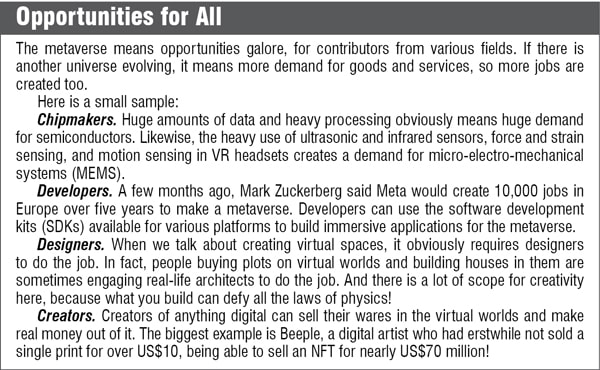 The metaverse, 29 years after its conceptualisation
The metaverse, 29 years after its conceptualisation
A lot of the advanced technology we see in reality today was once the realm of fiction. Neal Stephenson coined the term metaverse in his 1992 book Snow Crash. He described it as a parallel digital world where humans interact with each other in avatar form. Almost three decades later, venture capitalist Matthew Ball describes the metaverse as a massively-scaled and interoperable network of real-time rendered three-dimensional (3D) virtual worlds, which can be experienced synchronously and persistently by an effectively unlimited number of users.
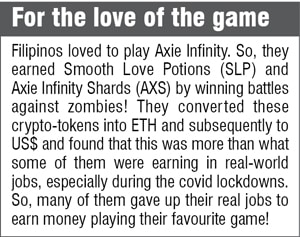 That answers all of you who are asking how the metaverse is different from the massively multi-player online (MMO) games, which are so popular today. The multiverse is not one virtual world—rather, it is a universe that brings together multiple virtual worlds. Over time, the virtual worlds will be connected and people will be able to go from world to world, carrying with them their things and money. Basically, their activities will not be tied to one world, but be spread across multiple platforms in the metaverse. That is the broad picture—although it is going to take time to get there.
That answers all of you who are asking how the metaverse is different from the massively multi-player online (MMO) games, which are so popular today. The multiverse is not one virtual world—rather, it is a universe that brings together multiple virtual worlds. Over time, the virtual worlds will be connected and people will be able to go from world to world, carrying with them their things and money. Basically, their activities will not be tied to one world, but be spread across multiple platforms in the metaverse. That is the broad picture—although it is going to take time to get there.
Not just that, the metaverse will also be a realm that blends real and digital worlds. For example, you will be mingling with real people, and making real money on the metaverse. It is not an entirely fictional world or a game. Satya Nadella, CEO of Microsoft, nailed it when he said the idea is to embed computing into the real world and to embed the real world into computing, bringing real presence to any digital space.
Dissecting the definitions
As we cut through the jargon, you will see that the metaverse is actually made up of several components—virtual worlds, virtual reality gear, digital currency, etc. This will also help you understand the spate of acquisitions going on in this space, as the tech majors like Meta and Microsoft try to bring together the different cogs that make the metaverse run.
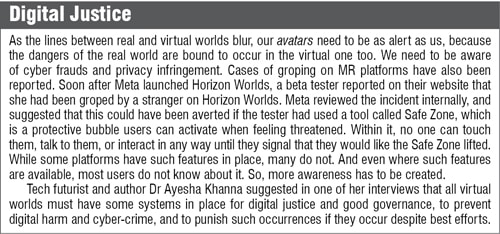 “The metaverse is a concept of virtual collaboration where people join shared three-dimensional (3D) environments as avatars, where they can talk, teach, learn, work, play and can also transact using blockchain tokens. Overall, it is a combination of 3D collaboration platforms, blockchain, non-fungible tokens (NFT), crypto-currency and gamification,” explains Pushpak Kypuram, Founder-Director, NextMeet, a Hyderabad based startup that has developed an immersive metaverse platform for meetups.
“The metaverse is a concept of virtual collaboration where people join shared three-dimensional (3D) environments as avatars, where they can talk, teach, learn, work, play and can also transact using blockchain tokens. Overall, it is a combination of 3D collaboration platforms, blockchain, non-fungible tokens (NFT), crypto-currency and gamification,” explains Pushpak Kypuram, Founder-Director, NextMeet, a Hyderabad based startup that has developed an immersive metaverse platform for meetups.
The metaverse is made up of virtual worlds
The metaverse, as we said, is made up of several virtual worlds, many of which are evolved gaming platforms. Second Life, for example, was launched in 2003. Although it seems like a game from the outside, its ‘residents’ take it quite seriously—it is their chance at a second life, where the first one has not met their expectations. It feels like being in a real world, where the residents explore, meet other residents, socialise, build, create, shop, and trade virtual property and services with one another.
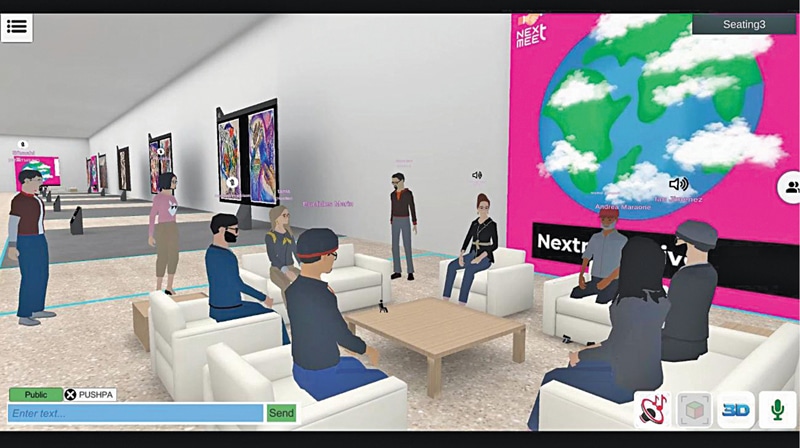
Way back in 2008, a couple even married each other on Second Life. They later met each other in the real world, and, thankfully hit it off. But it can also be the other way round; with couples getting divorced due to affairs in the virtual world.
Not all virtual worlds are, like, complete worlds. Some of them focus on some activities alone. For example, in World of Warcraft, Fortnite, Call of Duty, or Axie Infinity, you battle with villains to save the world. In Farmville, you focus on developing an awesome and profitable farm. In The Sandbox, you play God’s assistant, exploring and bringing together resources like water, soil, humans, wildlife, and machines to create stuff.

If you are tired of superhuman environments, then maybe you can go for the LokaLocal, a virtual world based on 3D maps of real-world cities and locations, where players can chill out in 3D versions of their favourite hangouts like Connaught Place in Delhi, Marine Drive in Mumbai, or MG Road in Bengaluru.
There are also virtual spaces for more serious work, like Microsoft Mesh and Meta’s Horizon Workplaces for collaborative meetings and design sessions, or NextMeet for meetups, and VRXtream for organising events.
Meta hopes to also bring you closer to your family and friends with Horizon Worlds and Horizon Homes, where, rather than fighting to save the world, you will be building escape rooms, social hangout spaces and party games to foster relationships.
So, now we know that there are multiple virtual worlds in this metaverse, each with different themes and purposes. If you look at it very objectively, these worlds are nothing but interoperable software platforms that you log in to for work or play. What makes them worthy of being called ‘worlds’ is their immersive nature, and ability to host thousands of people in a single instance of the server.
These worlds are immersive, and you enter them as avatars
Take Zoom or Google Meet—these are also ways of interacting with people. But everyone, including you, is just a thumbnail in it. You can see and talk to each other, but you are not really in the same space. The metaverse, on the other hand, is immersive and experiential. You enter this 3D digital space and become part of it, along with others. So, if you are playing with friends in Horizon Worlds, your avatars will be together in the same park or beach. If you are attending a math session, you will be sitting in a virtual classroom next to your friend.
So, to experience the metaverse, you first need an avatar, and then you need the tech gear to immerse yourself in the virtual world. Your avatar is, simply put, a 3D character that represents you in the digital world. You can create your own avatar, or customise available ones, most of which look like animated characters. However, the more serious and real-world applications emerging today will feel better if your avatar looks something like you. So, Epic Games owned company Unreal Engine has developed a tool called MetaHuman Creator, which would help you develop digital humans that look and behave pretty much like you.
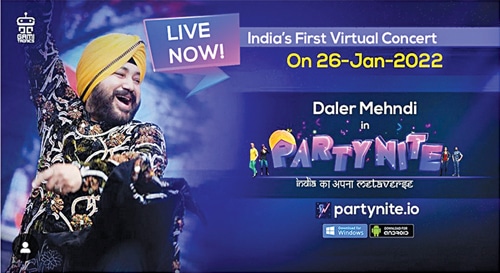
Once you have an avatar, you enter the virtual world. “Metaverse can be experienced using personal computers (PCs), laptops, mobiles, etc. Virtual reality (VR) and augmented reality (AR) are hardware technologies used to experience the metaverse. With VR, you are in a 360-degree immersive environment, whereas with AR you augment the 3D elements with the real world,” explains Kypuram. Going a step forward, we now have mixed reality (MR)—a form of AR where the real world and digital objects are not just visually interleaved but also interact with each other.
As the Rs (VR, AR, MR) keep increasing, we see them being brought under one umbrella term called extended reality (XR). According to VRdirect, the term simply represents any sort of technology that alters reality for the user by blurring the line between real and digital worlds. So, it combines VR, AR, and MR, as well as any new technologies that will come up in the future.
VR/MR headsets need no introduction to gaming enthusiasts—Oculus from Meta, HoloLens from Microsoft, and Playstation VR headsets from Sony, to name a few. VR headsets, most commonly used by serious gamers, will totally immerse you in a simulated environment using 3D vision, spatial sound, and motion trackers that sense movement of your eyeballs, and sometimes even jaw movements. The headsets usually come with handheld gaming controllers too. Some advanced sets might also include cameras to detect full body movement, and haptic feedback vests to give you a sense of touch—so you can feel it when your opponent punches you!
MR headsets go a step further to combine real-world and digital elements, usually using holographic display tech. Not an easy task, and right now they cost a whopping lot, but MR headsets might be the actual solution to balancing real and digital lives. Betting big on the metaverse, most of the industry majors are working on developing advanced MR headsets. Last year, Meta revealed two such projects—Project Nazare and Project Cambria. Apple is also developing an MR headset. Microsoft HoloLens 2 is a preferred MR headset for professional and industrial uses—but its lowest-end model costs most than US$3,000.
The problem with most headsets today is that they are not comfortable to wear for long durations, and do look a little odd when worn in public. Or perhaps it is a saving grace, as it naturally pulls out someone who tends to spend too much time in the virtual world.
You can manage without these Rs too
Leave alone an expensive MR set, the average internet user does not even have a VR headset. So, if you are conducting a university course on the metaverse, or a company town hall, how can all the employees participate?
“The metaverse can be experienced via PC and mobiles, but a VR or MR headset would enable users to experience real immersion. Right now, a decent VR headset would cost around US$300 and an MR headset would be around US$2,000. VR and MR technology is in motion, and it has gained good traction in some niche markets like industrial training and simulation. Once more affordable and comfortable VR/ MR headsets are in the market, it will become a consumer product. Right now, people who want to attend an event in the metaverse—say, a townhall conducted by their company—can come either on PC, mobile, or VR depending on the convenience and availability,” says Kypuram of NextMeet.
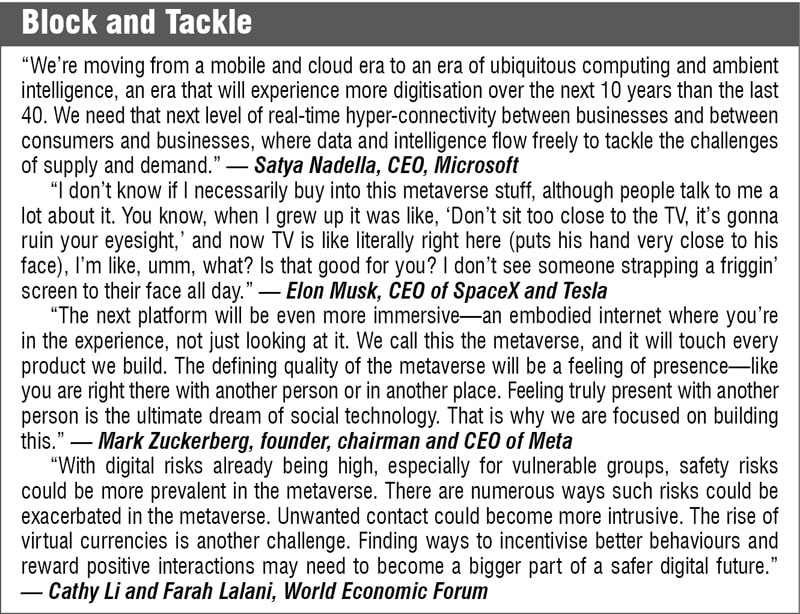 Vignesh Selvaraj, CEO, TardiVerse, shares similar sentiments. TardiVerse developed a Harry Potter themed space in their block-chain powered TardiWorld for Dinesh and Janaganandhini to celebrate their wedding reception with friends and family, without any restrictions on the number of guests! Given the cost of headsets, it would not have been possible for all the attendees to login with one. So, they decided to keep it simple. While they had special equipment for the wedding couple to be present at Hogwarts’ Great Hall, others just had to click on a web link, create a login for themselves, choose and customise an avatar, and enter. They could participate in events and games using simple mouse or touch screen controls. This is what is practically possible currently, but over time as headsets become more prevalent, people can immerse themselves fully—just like video gaming enthusiasts do already!
Vignesh Selvaraj, CEO, TardiVerse, shares similar sentiments. TardiVerse developed a Harry Potter themed space in their block-chain powered TardiWorld for Dinesh and Janaganandhini to celebrate their wedding reception with friends and family, without any restrictions on the number of guests! Given the cost of headsets, it would not have been possible for all the attendees to login with one. So, they decided to keep it simple. While they had special equipment for the wedding couple to be present at Hogwarts’ Great Hall, others just had to click on a web link, create a login for themselves, choose and customise an avatar, and enter. They could participate in events and games using simple mouse or touch screen controls. This is what is practically possible currently, but over time as headsets become more prevalent, people can immerse themselves fully—just like video gaming enthusiasts do already!
The metaverse supports economic activity
Virtual reality platforms are not new—we have been watching this space for a long time. The real twist in the metaverse story probably came when these make-believe worlds suddenly became hotbeds of commercial activity, and people started minting money. This is a subject in its own right, but for the sake of completeness we will attempt to give you a short overview of commerce in the metaverse.
When you think of trade, the two basic elements that come to mind are assets and currency. In a virtual world, these are powered by blockchain technology.
Assets are represented by non-fungible tokens or NFTs. A non-fungible token is a non-interchangeable unit of data stored on a blockchain. Think of it as a unique digital token that represents a digital asset. So, buying an NFT gives you ownership of the associated digital asset. Once an NFT has been encoded using blockchain technology, no one can alter its ownership data or metadata. Owners can prove its validity using blockchain verification. NFTs can be moved across different ecosystems owing to the open nature of block chain standards. So, you can trade NFTs outside the world in which you bought them! Ethereum is the most popular blockchain platform used for encoding NFTs, but one can also use others like Tezos, Algorand, or Polkadot.
Just as NFTs represent assets, crypto-currencies serve the equivalent of money. These are fungible tokens, that is, they can be interchanged. They are identical to each other and traded, hence an ideal medium for commercial transactions. Ether (ETH) is the native crypto-currency of the Ethereum platform. Every virtual world can have its own native currency, which can be converted into other crypto-currencies, or even real-world money based on prevailing conversion rates. For example, MANA is the native crypto-currency in Decentraland. Approximately 1123 MANA equals 1 ETH, and 1 ETH equals US$3,137.5 (you heard it right!), so 1 MANA is roughly US$2.8.
With the basic building blocks—assets and currencies—in place, marketplaces began to emerge in the virtual world. Some of the well-known ones are Decentraland to buy, develop, and sell virtual plots of land; OpenSea to trade in rare digital items and crypto-collectibles; SoRare for digital player cards and virtual teams; SuperRare and MakersPlace for authentic digital art; and so on. Almost every virtual world, in fact, has a marketplace that sells related ware.
Last year, Sotheby’s bought a plot of land in Decentraland and developed a metaverse store, which is an exact replica of its London store. In March 2021, Mike Winkelmann, a digital artist popularly known as Beeple, sold the NFT of one of his digital works for US$69 million at Christie’s. In December 2021, Adidas released its first range of NFTs (that sell for approximately 0.2ETH) at its showroom in The Sandbox. Nike has filed several trademark applications in the past couple of months for upcoming virtual rollouts. Last year, in February, the US based National Basketball Association’s online platform for NFT Basketball cards registered a sale of about US$250 million.
Gucci, Christian Dior, Ralph Lauren, all the fashion biggies have stores in 3D virtual worlds! And on the other end of the spectrum, Pizza Hut, Pringles, and Taco Bell are also selling themed NFTs.
One of the reasons for the popularity of these meta marketplaces is the ease of trading. You just setup a digital wallet, buy crypto-currency, connect your wallet to an NFT marketplace and start selling or bidding for an NFT—be it a plot of land, a collectible football card, or a rare piece of digital art.
Putting it to real use
A technology can garner attention but not sustain itself unless it proves to be really useful. Entertainment is a given, but will the meta worlds also improve the quality of our lives in the real world?
“People have been playing 3D games since the last three decades. Now, since remote working and learning is the norm, gamification will become necessary in these spaces too. Just like businesses have been developing websites on the internet for nearly three decades, now every brand will start having 3D experiential stores. Like mobile devices replacing desktop computers, eventually holographic projections will replace TV. Holographic eyewear are being manufactured by giants like Microsoft and Apple. It is not like we will be living inside 3D, but 3D will be a superimposed element in everyone’s life. Just like we have moved from button phones to touch phones, in the future we will operate gadgets using gestures as the user interfaces and user experiences shift to the 3D paradigm,” says Kypuram.
Experts say they are unable to visualise even the tip of the iceberg fully yet, because the possibilities are endless. Jog your mind, and you can list at least a dozen within a minute! Here is a small sample of what is possible.
Learning. The pandemic has taught us the importance of remote working. With the metaverse, learning could be so much more interactive and fun at school and university levels. You can get the feel of being in a real classroom with your friends, and it would be easier for the teacher too to explain stuff with holograms and 3D working models.
Work. Effective collaboration is expected to be one of the biggest benefits of the metaverse—and one that companies like Meta and Microsoft are betting big on. Colleagues can interact and brainstorm as if they were in the same room. Plus, the standards of collaboration—especially in design—would go up significantly with MR platforms.
In December 2021, a Reuter report spoke of Boeing’s plans to build its next plane in the metaverse. Its future factory will bring together engineers around the world using Microsoft HoloLens headsets, robots that speak to each other, and immersive 3D designs using holograms. I know that sounds like Tony Stark building something in the Marvel universe, but well it is bound to happen.
Events and workshops. Perhaps what people miss the most in remote working are the occasional events and workshops that liven things up and create opportunities to interact across the spectrum. Now, close-to-real events are possible in the virtual world.
NextMeet, for instance, has worked with Indian and international universities to organise virtual events and conferences. Their immersive 3D environment comes replete with avatars that can move around the space, 3D spatial voice, expo halls with banner hosting stands, presentation screens in the conference hall, help desks and networking lounges! VRXtream is another metaverse for events, where you can even buy spaces (stalls) and rent them out, or vice versa.
Healthcare. From training medical students to remote consultation and counselling, the metaverse is expected to benefit the medical world notably—and we can already see fragments of it in use. In a blog post that Microsoft put up last year showcasing their immersive MR platform, Mesh, the company imagined avatars of medical students learning about human anatomy, gathered around a holographic model and peeling back muscles to see what’s underneath. Hospitals are using MR platforms to help paramedics give first aid to patients, the World Health Organisation (WHO) used AR and smart phones to train Covid-19 response teams in remote areas, and psychiatrists are using VR to treat post-traumatic stress among combat soldiers.
Fitness and training. Maybe, exercising in the metaverse would be more fun! Zippy is a virtual world for runners, where people can run across major marathon cities like Boston, London, Mumbai, and Tokyo, or through scenic environments like jungle trails and beach runs. The virtual environment syncs with the real-world kinematics of the runners using their fitness wearables or treadmill sensors.
If you love fiction, then OliveX could have just the solution to add a spot of fun to your run! In association with award-winning novelist Naomi Alderman, the company has developed an ultra-immersive running game called Zombies, Run!, where every run is a mission to save the world. You run faster when you are chased by the zombies, and slow down to pick up supplies. The accompanying narration and music set the tempo for your run. What a fun way to exercise!
Or, if it is serious athletic practice that you are thinking about, Ghost Pacer might be of help. A solution developed by runners, for runners, these AR glasses project a live holographic opponent into your field of view, for you to compete with and train against.
Retail. Everyone loves to shop. But the pandemic made us realise that physical store shopping is not something we can take for granted. So, for those times when you want to shop but cannot go out, or if you are too busy to shop hop, then you can turn to the showrooms that are slowly mushrooming in the metaverse. From real estate to automobiles, sellers are building unique experiences to woo shoppers. Real estate agents could give you virtual tours of their properties, you could walk around a virtual clothing store and experience the latest in fashion, or test drive a car virtually!
Social media. This is one space Meta is betting big on. Imagine what happens when your social media apps become immersive? Your friends from different parts of the world could manifest in your living room as holograms! Quite some time for that level of interaction to become mainstream, but, as of now, we commonly see friends hanging out together in shared virtual spaces.
Honestly, there is too much to dream about in the metaverse. Avatars might be living in huge mansions in plush downtown neighbourhoods, driving luxury cars, going on cruises and watching their favourite movies on wall-sized screens. But, in real life, the same people might be living in hostels, having no television, not even a bicycle, and maybe no real friends to call their own.
When one snaps out of the dream, it might be very difficult to come to terms with reality. The huge disparity between the real and virtual lives could even lead to psychological disorders. So, we need to know where to draw the line, as in the case of any technological advancement.
Janani Gopalakrishnan Vikram is a freelance writer based in Chennai, who loves to write on emerging technologies and Indian culture. She believes in relishing every moment of life, as happy memories are the best savings for the future








